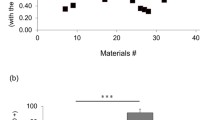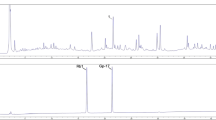Abstract
It was previously demonstrated that Menta-FX, a mixture of Panax quinquefolius L. (PQE), Ginkgo biloba (GBE), and Hypericum perforatum extracts (HPE), enhances retinal ganglion cell survival after axotomy. However, the mechanisms of neuroprotection remain unknown. The aim of this study is to elucidate the neuroprotective mechanisms of Menta-FX. Since PQE, GBE and HPE have all been observed to display anti-oxidative property, the involvement of anti-oxidation in Menta-FX’s neuroprotective effect was investigated. Menta-FX lowered nitric oxide (NO) content in axotomized retinas without affecting nitric oxide synthase activity, suggesting that Menta-FX possibly exhibited a NO scavenging property. In addition, the effect of Menta-FX on the frequency of axotomy-induced nuclear fragmentation and caspase-3 activation was investigated. Menta-FX treatment significantly reduced nuclear fragmentation in axotomized retinas. Surprisingly, Menta-FX had no effect on caspase-3 activation, but selectively lowered caspase-3-independent nuclear fragmentation in axotomized retinal ganglion cells. In addition, inhibition of PI3K activity by intravitreal injection of wortmannin, a phosphoinositide-3 kinase (PI3K) inhibitor, completely abolished the neuroprotective effect of Menta-FX, indicating that Menta-FX’s neuroprotective effect was PI3K-dependent. Data here suggest that Menta-FX displayed a PI3K-dependent, selective inhibition on a caspase-3-independent apoptotic pathway in axotomized RGCs, thus, highlighting the potential use of herbal remedies as neuroprotective agents for other neurodegenerative diseases.








Similar content being viewed by others
References
Ball AK, Keoberle PD (1999) Nitric oxide synthase inhibition delays axonal degeneration and promotes the survival of axotomized retinal ganglion cells. Exp Neurol 158:366–381
Barber AJ, Nakamura M, Wolpert EB, Reiter CE, Seigel GM, Antonetti DA, Gardner TW (2001) Insulin rescues retinal neurons from apoptosis by a phosphatidylinositol 3-kinase/Akt-mediated mechanism that reduces the activation of caspase-3. J Biol Chem 276:32814–32821
Bastianetto S, Ramassamy C, Dore S, Christen Y, Poirier J, Quirion R (2000) The Ginkgo biloba extract (EGb 761) protects hippocampal neurons against cell death induced by beta-amyloid. Eur J Neurosci 12:1882–1890
Baudouin C, Pisella PJ, Ettaiche M, Goldschild M, Becquet F, Gastaud P, Droy-Lefaix MT (1999) Effects of EGb761 and superoxide dismutase in an experimental model of retinopathy generated by intravitreal production of superoxide anion radical. Graefes Arch Clin Exp Ophthalmol 237:58–66
Belmokhtar CA, Hillion J, Segal-Bendirdjian E (2001) Staurosporine induces apoptosis through both caspase-dependent and caspase-independent mechanisms. Oncogene 20:3354–3362
Blajeski AL, Kaufmann SH (1999) Methods for detecting proteolysis during apoptosis in intact cells. In: Studzinski GP (ed) Apoptosis: a practical approach. Oxford University Press, New York, pp 215–238
Cardone MH, Roy N, Stennicke HR, Salvesen GS, Franke TF, Stanbridge E, Frisch S, Reed JC (1998) Regulation of cell death protease caspase-9 by phosphorylation. Science 282:1318–1321
Cheung ZH, So KF, Lu Q, Yip HK, Wu W, Shan JJ, Pang PK, Chen CF (2002) Enhanced survival and regeneration of axotomized retinal ganglion cells by a mixture of herbal extracts. J Neurotrauma 19:369–378
Cheung ZH, Chan YM, Siu FK, Yip HK, Wu W, Leung MC, So KF (2004) Regulation of caspase activation in axotomized retinal ganglion cells. Mol Cell Neurosci 25:383–393
Darzynkiewics Z, Traganos F (1998) Measurement of apoptosis. In: Al-Rubeai M (ed) Apoptosis. Springer, Berlin, pp 33–74
Daugas E, Nochy D, Ravagnan L, Loeffler M, Susin SA, Zamzami N, Kroemer G (2000) Apoptosis-inducing factor (AIF): a ubiquitous mitochondrial oxidoreductase involved in apoptosis. FEBS Lett 476:118–123
Deshmukh M, Johnson EM Jr (2000) Staurosporine-induced neuronal death: multiple mechanisms and methodological implications. Cell Death Differ 7:250–261
Dos SA, De Araujo EG (2000) The effect of PKC activation on the survival of rat retinal ganglion cells in culture. Brain Res 853:338–343
Dudek H, Datta SR, Franke TF, Birnbaum MJ, Yao R, Cooper GM, Segal RA, Kaplan DR, Greenberg ME (1997) Regulation of neuronal survival by the serine-threonine protein kinase Akt. Science 275:661–665
Franke TF, Kaplan DR, Cantley LC (1997) PI3K: downstream AKTion blocks apoptosis. Cell 88:435–437
Franklin M, Chi J, McGavin C, Hockney R, Reed A, Campling G, Whale RW, Cowen PJ (1999) Neuroendocrine evidence for dopaminergic actions of hypericum extract (LI 160) in healthy volunteers. Biol Psychiatry 46:581–584
Fuller G, Veitch K, Ho LK, Cruise L, Morris BJ (2001) Activation of p44/p42 MAP kinase in striatal neurons via kainate receptors and PI3 kinase. Brain Res Mol Brain Res 89:126–132
Isenmann S, Wahl C, Krajewski S, Reed JC, Bahr M (1997) Up-regulation of Bax protein in degenerating retinal ganglion cells precedes apoptotic cell death after optic nerve lesion in the rat. Eur J Neurosci 9:1763–1772
Kawasaki A, Otori Y, Barnstable CJ (2000) Muller cell protection of rat retinal ganglion cells from glutamate and nitric oxide neurotoxicity. Invest Ophthalmol Vis Sci 41:3444–3450
Kermer P, Klocker N, Labes M, Thomsen S, Srinivasan A, Bahr M (1999) Activation of caspase-3 in axotomized rat retinal ganglion cells in vivo. FEBS Lett 453:361–364
Kermer P, Ankerhold R, Klocker N, Krajewski S, Reed JC, Bahr M (2000a) Caspase-9: involvement in secondary death of axotomized rat retinal ganglion cells in vivo. Brain Res Mol Brain Res 85:144–150
Kermer P, Klocker N, Labes M, Bahr M (2000b) Insulin-like growth factor-I protects axotomized rat retinal ganglion cells from secondary death via PI3-K-dependent Akt phosphorylation and inhibition of caspase-3 in vivo. J Neurosci 20:2–8
Kim YC, Kim SR, Markelonis GJ, Oh TH (1998) Ginsenosides Rb1 and Rg3 protect cultured rat cortical cells from glutamate-induced neurodegeneration [published erratum appears in J Neurosci Res 1998 Oct 1; 54(1): 123]. J Neurosci Res 53:426–432
Kitts DD, Wijewickreme AN, Hu C (2000) Antioxidant properties of a North American ginseng extract. Mol Cell Biochem 203:1–10
Klocker N, Kermer P, Weishaupt JH, Labes M, Ankerhold R, Bahr M (2000) Brain-derived neurotrophic factor-mediated neuroprotection of adult rat retinal ganglion cells in vivo does not exclusively depend on phosphatidyl-inositol-3′-kinase/protein kinase B signaling. J Neurosci 20:6962–6967
Liao J, Xu X, Wargovich MJ (2000) Direct reprobing with anti-beta-actin antibody as an internal control for western blotting analysis. Biotechniques 28:216–218
Lipton SA (1999) Neuronal protection and destruction by NO. Cell Death Differ 6:943–951
Liu W, Liu R, Chun JT, Bi R, Hoe W, Schreiber SS, Baudry M (2001) Kainate excitotoxicity in organotypic hippocampal slice cultures: evidence for multiple apoptotic pathways. Brain Res 916:239–248
Marcocci L, Maguire JJ, Droy-Lefaix MT, Packer L (1994) The nitric oxide-scavenging properties of Ginkgo biloba extract EGb 761. Biochem Biophys Res Commun 201:748–755
Namikawa K, Honma M, Abe K, Takeda M, Mansur K, Obata T, Miwa A, Okado H, Kiyama H (2000) Akt/protein kinase B prevents injury-induced motoneuron death and accelerates axonal regeneration. J Neurosci 20:2875–2886
Nunez G, Del Peso L (1998) Linking extracellular survival signals and the apoptotic machinery. Curr Opin Neurobiol 8:613–618
Politi LE, Rotstein NP, Salvador G, Giusto NM, Insua MF (2001) Insulin-like growth factor-I is a potential trophic factor for amacrine cells. J Neurochem 76:1199–1211
Ranchon I, Gorrand JM, Cluzel J, Droy-Lefaix MT, Doly M (1999) Functional protection of photoreceptors from light-induced damage by dimethylthiourea and Ginkgo biloba extract. Invest Ophthalmol Vis Sci 40:1191–1199
Reed JC (2000) Mechanisms of apoptosis. Am J Pathol 157:1415–1430
Roux PP, Bhakar AL, Kennedy TE, Barker PA (2001) The p75 neurotrophin receptor activates Akt (protein kinase B) through a phosphatidylinositol 3-kinase-dependent pathway. J Biol Chem 276:23097–23104
Sarmiere PD, Freeman RS (2001) Analysis of the nf-kappab and pi 3-kinase/akt survival pathways in nerve growth factor-dependent neurons. Mol Cell Neurosci 18:320–331
Tripathi YB, Pandey E (1999) Role of alcoholic extract of shoot of Hypericum perforatum Linn on lipid peroxidation and various species of free radicals in rats. Indian J Exp Biol 37:567–571
Wang X, Mccullough KD, Franke TF, Holbrook NJ (2000) Epidermal growth factor receptor-dependent Akt activation by oxidative stress enhances cell survival. J Biol Chem 275:14624–14631
Wei T, Ni Y, Hou J, Chen C, Zhao B, Xin W (2000) Hydrogen peroxide-induced oxidative damage and apoptosis in cerebellar granule cells: protection by Ginkgo biloba extract. Pharmacol Res 41:427–433
You SW, Tay D, So KF, Yip HK, Lau KC (1998) Effects of nitric oxide synthase inhibitor on the neuronal survival and axonal regeneration of retinal ganglion cells in hamsters. Proc Aust Neuroscience Soc 9:98
Yuan J, Yankner BA (2000) Apoptosis in the nervous system. Nature 407:802–809
Zhivotovsky B, Samali A, Gahm A, Orrenius S (1999) Caspases: their intracellular localization and translocation during apoptosis. Cell Death Differ 6:644–651
Zhou H, Li XM, Meinkoth J, Pittman RN (2000) Akt regulates cell survival and apoptosis at a postmitochondrial level. J Cell Biol 151:483–494
Acknowledgements
The authors would like to thank Miss Reiko Cheung and Mr. K.K. Yip for their technical assistance in the Western blotting. This research is supported by donations from the Hong Kong Charitable Foundation, and Ms. Annie Tsao Wen Wei, and an ASD grant from the Hong Kong Polytechnic University, China. Z.H. Cheung was supported by a scholarship from the Croucher Foundation, Hong Kong.
Author information
Authors and Affiliations
Corresponding author
Rights and permissions
About this article
Cite this article
Cheung, Z.H., Leung, M.C.P., Yip, H.K. et al. A Neuroprotective Herbal Mixture Inhibits Caspase-3-independent Apoptosis in Retinal Ganglion Cells. Cell Mol Neurobiol 28, 137–155 (2008). https://doi.org/10.1007/s10571-007-9175-8
Received:
Accepted:
Published:
Issue Date:
DOI: https://doi.org/10.1007/s10571-007-9175-8




